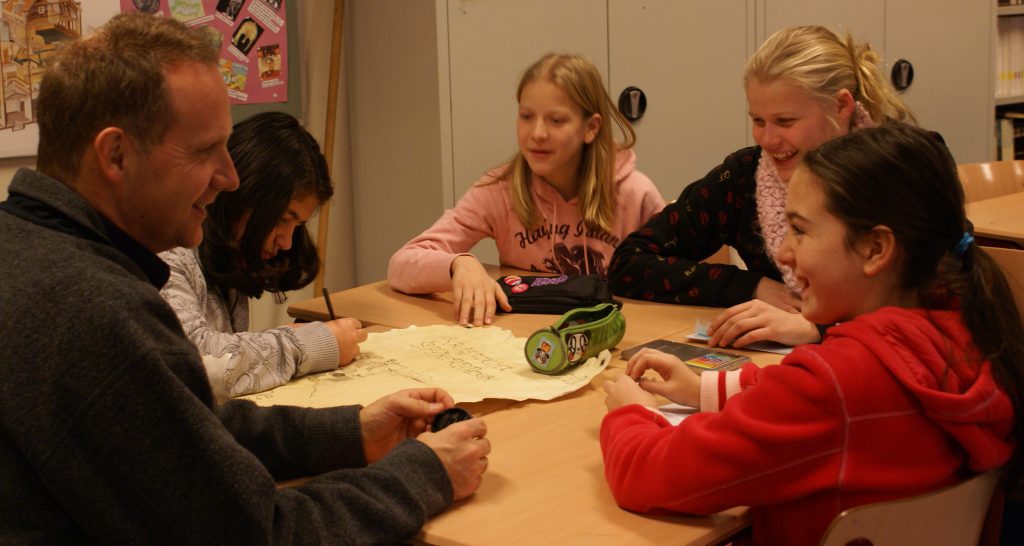
In a few weeks, Rolf Nijman will retire after working 41 years as a teacher in secondary education. Over the years he has experienced different eras in the classroom, from the days without internet in the 1980s to the current use of artificial intelligence in schools. The changes have been significant, and not just for the students in the classroom but also for those now training to become teachers. "You’re going to experience a lot," says Rolf.
In September 1984, Rolf had his very first class at a secondary school in Hilversum. Becoming a teacher had not always been his goal, yet he turned out to have a real passion for it. "I originally wanted to study veterinary medicine, but in my fourth year of pre-university education I realized that chemistry and physics weren’t my strongest subjects."
Rolf completed his teacher training in Amsterdam, earning three teaching qualifications. "My three qualifications are for Dutch language, history and drama," he says. He also started a university degree in history, but didn’t finish it. Youth unemployment was extremely high in the 1980s, making it difficult for young people to find a job after their studies. On top of that, there were major cuts to salaries. "A friend and I went to the employment office when we were both 25 years old. The person behind the counter told us we might as well retire, because there was literally no work for us," he recalls. This was Generation X, also known as the "lost generation". It's the generation that came after the baby boomers. For most young adults at the time, it was a rough start to their careers. But in the end, things worked out, including for Rolf.
Carried a box between three schools
"I got a substitute teaching job in Hilversum through someone I knew. At the time, I was still living in Amsterdam." Rolf was convinced he wouldn’t find work if he finished his university degree. So in 1984, he started teaching at three different secondary schools in Hilversum. "I had a box of books in the back of my car. Every day I drove from Amsterdam to Hilversum and went from school to school during the breaks. Honestly, it was tough, but on the other hand, I was just happy to have a job." This went on for a few years, until two of the three schools eventually merged, which meant Rolf then worked at two schools. "In the end, I stayed at Comenius College."
Support for trainee teachers is much better today than it was in the 1980s. Back then, it was mostly a matter of figuring out the teaching profession on your own. You had to find your own way in the job. "It makes you stronger, but it certainly wasn’t easy. At the time, there was no teacher shortage, so the authorities didn’t see much need to make things easier for trainee teachers," says Rolf.
Religion in class
“Teenagers will always be teenagers, but I’d even dare to say that in the 1980s they were just a little bit naughtier than today’s youth. At the same time, they were often remarkably politically and socially engaged, which led to deep conversations in the classroom, conversations that are less common nowadays.”
School played a central role in the lives of students back then and was at the heart of their social world. There were big parties, school newspapers that were genuinely created by the students themselves, and almost all activities took place within the school walls. Most students didn’t have their own money and focused entirely on their time at school.
At that time, school was the center of their lives, something that has clearly shifted today. Nowadays, school is just one part of young people’s lives, alongside sports clubs, part-time jobs, and social media. In the early 1980s, open days didn’t even exist yet. The pillarization had just ended, but school choice was still largely determined by the family’s religious background. Protestant children naturally attended Comenius College, while Catholic students went to Alberdingk Thijm College. Everyone more or less followed their own path, guided by the norms and customs of home.
''When I taught history, I sometimes asked my class who went to church every Sunday. Back then, about ninety percent of the students would raise their hand. If I asked that same question now, in 2025, the percentage would probably be reversed. This difference clearly shows how much the role of religion in society has changed. The classroom itself was also arranged differently than it is today. We worked with chalkboards and white chalk, whereas nowadays every classroom is equipped with a smartboard and almost every student has their own laptop. Teaching materials weren’t copied like they are now, but reproduced using a stencil machine, a cumbersome but common process at the time.''
Use of sources at school and work
Nowadays, it has become much easier for students to find information. "In my time, it was different. The main source of information was the encyclopedia, and I had a subscription to one that was quite expensive. Still, you had little choice, because whether you had to do a school assignment or prepare a lesson as a teacher, the encyclopedia was basically the go-to source," says Rolf.
Rolf studied in Amsterdam back then. "I like to share an anecdote about this. If you needed a specific book or source for a paper, you had to go to the university library at Koningsplein in Amsterdam. There, you stood in a large room full of steel cabinets with drawers containing cardboard cards listing book titles. Once you finally found the card for the right book, you took it to a counter. You handed it over, and then a staff member, sometimes on roller skates, would head down into the huge basement to find that one book for you. It could easily take an hour before you finally got what you needed."
Nowadays, you can access thousands of sources and articles within seconds via the internet. “Back then, such a search could take you half a day. And once you had written your work, a teacher might reject it with a red pen. Then you had to start over and retype everything on a typewriter. Now you can easily share a document digitally with colleagues or students, who can add comments, make suggestions, or collaborate on the content.”

Reading skills among students
“What I do find unfortunate is that young people’s reading skills have declined significantly,” says Rolf. He sees a clear shift, partly caused by technological developments. “Children used to read many more books. Books were not only the main source of information but also one of the few forms of entertainment. Television existed, but there was only one channel named Nederland 1, and children’s programs were broadcast only on Wednesday afternoons. Often there was just one household nearby with a TV, so the children would gather there to watch together. Otherwise, you read a book or played outside.”
“Because reading was such a natural part of daily life, children back then developed stronger skills in reading comprehension.” Rolf doesn’t see this same development to the same extent today. Young people nowadays struggle with understanding texts, and that worries him. “Reading and understanding texts is, after all, an important part of knowledge transfer in education.”
Nowadays, young people get their information from all kinds of sources, like social media or ChatGPT. This makes the learning process shorter and more superficial. “Instead of building knowledge step by step and understanding why something is the way it is, they now get the answer served to them in just a few seconds. But without the process of discovering and understanding, that knowledge doesn’t stick as well. It doesn’t necessarily make them wiser.”
The trends among teenagers
Trends among young people have always existed. Even in the seventies and eighties, young people followed what was popular at the time. They were mainly inspired by their favorite artists, which showed in their clothing and behavior. “Anyone who was a fan of Stevie Wonder looked different from someone who loved The Rolling Stones. At school, there were all kinds of groups with their own style. Some young people wore long hair, jeans, and denim jackets. That was the fashion back then. And if you belonged to one group, you usually didn’t like the style of another group. Everyone picked a side, and your appearance showed who you belonged to,” says Rolf.
“If you go even further back to the sixties and seventies, when I was young myself, music also played a big role. You bought records at the record store. On the radio, there was the Top 40, a list of the most popular songs of the week. Every week, you hoped your favorite artist would be on it. Buying a record was something special. They were expensive, so you had to save up for them. I was a fan of The Beatles myself. When I finally had enough money for one of their records, I proudly walked down the street with the bag in my hand. That was a real moment of happiness.”
“You can’t stop new developments. Time always moves forward, and as a person, you have to learn to go with the flow. It’s important to understand how to deal with these changes so you can pass that on to others. Many new things will come our way in the future, especially in technology and social behavior. Today’s teachers will face their own challenges. But by staying open to change, you keep learning and can better respond to what is needed in tomorrow’s education.”



